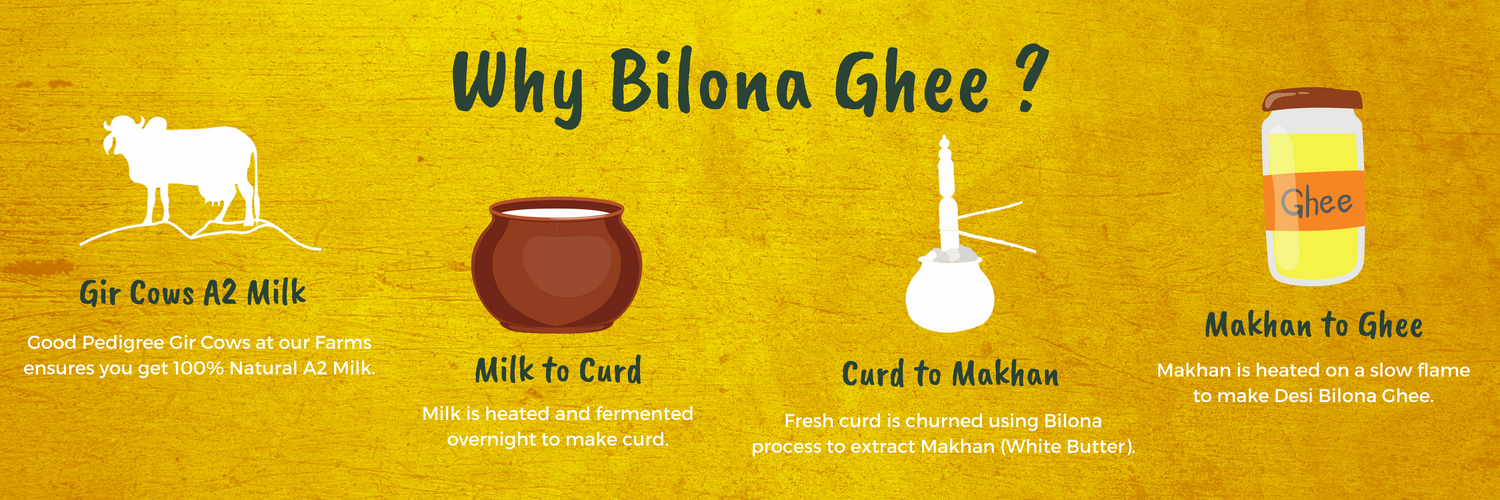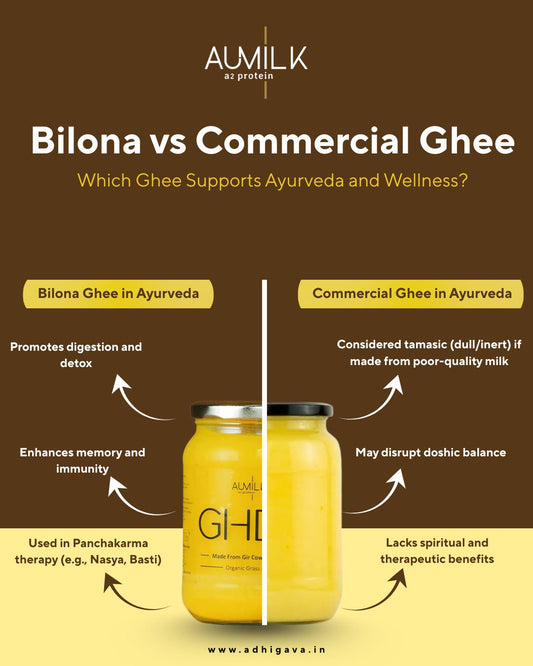Can Diabetics Eat Ghee? Here's What You Should Know
Let’s face it—ghee is the crown jewel of every Indian kitchen. Whether it's drizzled on hot rotis, added to dal tadka, or used to roast cumin seeds, ghee has been an inseparable part of Indian cuisine for generations. Our grandparents swore by it, and Ayurveda calls it liquid gold. But with rising health concerns, especially diabetes, many have begun to question: is ghee still a safe choice?
If you’re diabetic or know someone who is, you’ve probably heard the conflicting advice. Some say it's loaded with fat and should be avoided. Others claim it's a superfood with multiple benefits. So, what's the real deal?
Here’s the truth—ghee, especially A2 Bilona Ghee made from Desi Gir Cows like the one offered by Adhigava Farm, isn’t your enemy. In fact, when used right, it can be your ally. Unlike refined oils, ghee is rich in fat-soluble vitamins (A, D, E, and K), has powerful anti-inflammatory properties, and actually helps in better nutrient absorption. It’s not the ghee that’s harmful, but how much and what kind you consume.
For diabetics, moderation is the magic word. A spoonful of quality A2 Gir Cow Ghee with meals can actually help stabilize blood sugar levels by slowing down the absorption of carbohydrates. The key is to opt for organic, traditionally-made ghee and use it smartly.
Busting Common Myths About Ghee and Diabetes
When it comes to diabetes, there's no shortage of advice—and myths. Especially about ghee. Some believe it spikes blood sugar. Others think it clogs arteries. And then there’s the classic: “If you’re diabetic, you must avoid ghee completely.”
This couldn’t be further from the truth.
These myths often stem from outdated nutritional guidelines that demonized all fats. But recent studies and holistic practices like Ayurveda have flipped the script. Ghee is no longer seen as the villain; it's viewed as a healthy fat that, when consumed in moderation, plays a supportive role in metabolic and overall health.
Before we dive deeper into the truth about ghee, let’s lay these myths to rest one by one. Understanding what’s real and what’s not can empower diabetics to make better dietary choices—without missing out on their favorite flavors.
Myth 1: Ghee Causes Weight Gain – The Real Story
If you’re diabetic and trying to manage your weight, you might think all fats are bad. That’s a myth we need to clear up right now. Ghee, especially A2 Desi Cow Ghee, is packed with healthy saturated fats that help keep you full for longer and prevent overeating. It’s not the ghee that causes weight gain—it’s the excess of processed foods and sedentary lifestyles.
Here’s a cool fact: healthy fats like those in bilona ghee slow the release of sugar into your bloodstream, which means fewer sugar spikes and crashes. This keeps your energy levels more stable and curbs hunger pangs that lead to binge eating.
Plus, desi ghee contains butyrate, a short-chain fatty acid that supports gut health and boosts metabolism. So, instead of contributing to fat gain, it may actually help your body burn fat more efficiently—when used wisely.
Think of ghee like a financial investment. If you put in too much, you might risk overspending (or overeating). But if you manage it right, the returns (in terms of energy and health) can be remarkable.

Myth 2: Ghee Raises Blood Sugar – Fact or Fiction?
This one’s a biggie. Many diabetics avoid ghee thinking it directly increases blood sugar. But here’s the kicker—ghee contains zero carbohydrates. That’s right, zilch. No sugar, no starch, nothing that directly impacts your glucose levels.
So, how did this myth even start? Likely because ghee is often consumed with carbs—think rice, chapati, or parathas. But what we often overlook is that adding ghee to these foods can actually slow down the digestion and absorption of carbohydrates, thanks to its high fat content. This means a slower and steadier release of glucose into the bloodstream.
Another bonus? Ghee helps in the absorption of fat-soluble vitamins like D, which is crucial for insulin sensitivity. Studies suggest that low vitamin D levels are linked with poor blood sugar control, so adding ghee to your diet could indirectly support your diabetic health.
So no, ghee doesn’t raise blood sugar—if anything, it can help stabilize it.
Myth 3: Ghee Harms Heart Health – Debunking the Concern
The idea that ghee clogs arteries and causes heart disease is a relic of the 1980s. Modern science, especially studies conducted in India on A2 cow ghee, paint a very different picture.
First, it’s essential to understand that not all saturated fats are created equal. The saturated fat in pure, organic desi cow ghee—particularly the kind made using the bilona method—is not the same as that found in deep-fried fast food. Ghee also contains omega-3 fatty acids and conjugated linoleic acid (CLA), which are actually heart-friendly.
Plus, ghee has anti-inflammatory properties, which can help reduce arterial inflammation—a key factor in heart disease. In Ayurveda, ghee has always been prescribed for balancing the body's internal systems, including the cardiovascular system.
What truly matters is quality and quantity. Choose high-quality A2 Gir Cow Ghee from Adhigava Farm, and stick to about 1–2 teaspoons per meal. That’s all it takes to enjoy its heart-healthy benefits without the guilt.
Myth 4: Ghee Has No Nutritional Value – Think Again
This myth probably arose from comparing ghee to industrial oils or fats that are stripped of nutrition. But if you're using pure desi ghee, especially from a trusted source like Adhigava Farm's A2 Gir Cow Ghee, you’re actually nourishing your body with some powerful nutrients.
Ghee is rich in fat-soluble vitamins A, D, E, and K—each playing a crucial role in a diabetic's health journey. Vitamin A supports eye health, which is vital as diabetics are more prone to vision problems. Vitamin D is essential for insulin function. Vitamin E is a potent antioxidant that helps prevent cellular damage, and Vitamin K supports bone health and cardiovascular function.
Moreover, A2 Bilona Ghee is loaded with conjugated linoleic acid (CLA) and butyric acid, both known to reduce inflammation, enhance metabolism, and promote gut health. Diabetics often struggle with digestive issues, so a spoonful of this ghee can soothe the digestive system while improving nutrient absorption.
So yes, ghee is far from nutritionally empty. In fact, it’s a powerhouse—just waiting to be appreciated in the right way.
Myth 5: Diabetics Must Avoid Ghee – Is That True?
This one’s deeply rooted in fear. Many diabetics cut out ghee entirely, thinking it’s safer. But in doing so, they miss out on all its metabolic and therapeutic benefits.
Eliminating ghee is not only unnecessary—it might be counterproductive. The healthy fats in A2 Ghee play a role in stabilizing blood sugar, improving digestion, and reducing inflammation. In fact, bilona cow ghee, especially when sourced from organic desi cows, has been shown to support insulin function and boost metabolism.
Of course, portion control is key. Just like overloading on sugar isn’t good, neither is drowning your food in ghee. But 1 to 2 teaspoons per meal can actually make meals more satisfying and reduce sugar cravings.
Think about it this way: diabetics don’t need to cut ghee—they just need to upgrade their ghee game and control how much they use. And when it comes to quality, Adhigava Farm’s A2 Organic Ghee is about as premium as it gets.
How Ghee Supports Blood Sugar Control in Diabetics
Now here’s the good stuff—how does ghee actually help regulate blood sugar?
When you eat carbohydrates, your blood sugar rises. But when those carbs are combined with a healthy fat like ghee, something magical happens: digestion slows down. This means the glucose enters your bloodstream more gradually, preventing sharp spikes and crashes. That’s a big win for blood sugar control.
Moreover, desi ghee enhances insulin sensitivity, which is crucial for diabetics. It also contains medium-chain fatty acids (MCFAs) that are easier to digest and don’t get stored as fat. Instead, they’re used directly for energy, reducing the burden on the pancreas.
Let’s not forget the anti-inflammatory properties of ghee, especially when it’s made from A2 milk of Gir cows. Chronic inflammation is a common problem in diabetics and a major contributor to insulin resistance. Ghee helps cool that inflammation and protect your metabolic system.
So, rather than avoiding it, a diabetic-friendly meal plan should embrace a touch of high-quality A2 cow ghee—it could be your secret blood sugar stabilizer.
The Right Way to Use Ghee in a Diabetic Diet
The biggest mistake people make is not how much ghee they use—but how they use it.
Here’s the right way: don’t fry your food in heaps of ghee. Instead, use it as a finishing fat—drizzle a small amount over your dal, smear it lightly on your roti, or mix it into your hot khichdi just before serving. This method preserves the ghee’s nutrients and adds flavor without making the dish too heavy.
Also, try pairing ghee with low-GI foods like whole grains, millets, lentils, and vegetables. The fat in ghee slows down the absorption of sugars from these carbs, reducing glucose spikes and keeping you full longer.
Another tip? Stick with A2 Bilona Ghee, especially the kind made from Desi Gir Cows. Adhigava Farm’s ghee is made using the ancient bilona method, which ensures purity, nutrient retention, and zero chemicals—perfect for a diabetic diet.
Keep in mind, every drop of ghee counts. Using it thoughtfully makes all the difference between a healthful addition and a caloric overload.
Ideal Ghee Portion Size for Diabetics in India
So, how much is too much? Or better yet—how much is just right?
Experts suggest that diabetics can safely consume about 1 to 2 teaspoons (5 to 10 grams) of ghee per meal. That’s about 15 to 25 grams per day for an average adult, depending on overall calorie needs and physical activity.
If you're using high-quality A2 desi ghee, you don’t need a lot to get the benefits. A teaspoon of Adhigava Farm’s pure ghee packs rich flavor and nutrition, making even the simplest meal feel complete.
Here are some easy portion control tips:
-
Use a measuring spoon to avoid guesswork.
-
Add ghee at the end of cooking to enhance aroma and minimize overuse.
-
Avoid mixing ghee with other fats in the same dish—stick to one healthy fat at a time.
-
Don't treat ghee as a freebie—account for it in your total calorie intake.
Remember, ghee is like a fine spice—small amounts deliver big impact. Especially when it’s made the traditional way and used mindfully.
Best Times to Consume Ghee for Diabetics
Timing matters—not just in life, but also when it comes to nutrition. For diabetics, knowing when to consume ghee can make a real difference in how it affects blood sugar and digestion.
One of the best times to consume ghee is in the morning, on an empty stomach or with your first meal. In Ayurveda, a small spoonful of desi cow ghee, especially from A2 Gir cows, is often recommended as part of morning rituals. It kickstarts digestion, lubricates internal organs, and supports a smooth bowel movement—something diabetics often struggle with.
Another excellent time is during meals, particularly those that include carbohydrates. Adding a teaspoon of pure bilona ghee to your dal, roti, or rice can help slow down the carbohydrate digestion process, leading to steadier post-meal blood sugar levels.
Avoid having ghee late at night or in heavy amounts close to bedtime—it’s harder to digest and might interfere with restful sleep. Instead, pair ghee strategically with fiber-rich and protein-rich foods during the day for the best impact.
So, think of ghee as your meal enhancer. Not only does it boost flavor, but it also helps you stay full, satisfied, and balanced—especially when consumed at the right time.

Choose Quality: A2 Bilona Ghee and Its Diabetic Benefits
Not all ghee is created equal. If you’re diabetic, the type of ghee you choose could make or break its health benefits.
The gold standard? A2 Bilona Ghee from Desi Gir Cows—like the one produced by Adhigava Farm. This ghee is made using traditional bilona methods, which involve curd churning and slow hand-processing. No shortcuts. No chemicals. Just wholesome, nutrient-rich goodness.
What makes A2 ghee so special? It comes from cows that produce the A2 beta-casein protein, which is easier to digest and less inflammatory than the A1 protein found in most commercial dairy. That’s a huge plus for diabetics who often have gut sensitivities or inflammatory conditions.
A2 ghee is also richer in:
-
Omega-3 fatty acids
-
Butyrate (for gut health)
-
CLA (for fat metabolism and insulin support)
-
Fat-soluble vitamins like A, D, E, and K
When choosing ghee, look for labels that say “A2,” “Bilona,” and “Desi Cow”. Brands like Adhigava Farm ensure authenticity, transparency, and top-tier quality that your body will thank you for—especially if you’re managing diabetes.
So remember: if you're going to use ghee, make it count. Choose the purest, most traditional version available.
Cooking with Ghee: Healthy Indian Recipes for Diabetics
Let’s get practical—how can you actually use ghee in your kitchen every day?
Here are a few diabetic-friendly Indian meals where a touch of ghee can enhance both taste and health:
-
Moong Dal Tadka: Instead of using refined oil, finish your dal with a teaspoon of pure gir cow ghee. The aroma and richness are unbeatable—and it helps you absorb all those plant-based nutrients better.
-
Vegetable Khichdi: Mix brown rice and moong dal with plenty of veggies and add a teaspoon of A2 bilona ghee just before serving. It’s comfort food that keeps your sugar levels happy.
-
Masoor Dal Soup: Add a dollop of ghee while blending or serving to improve texture and flavor while making the dish more filling.
-
Ghee-Roasted Sabzi: Roast low-GI veggies like lauki, bhindi, or karela in a little ghee with cumin and turmeric. Ghee makes the flavors pop without adding sugar.
When you use Adhigava Farm’s A2 Ghee, even simple meals feel gourmet. Just remember to go easy on the quantity and focus on cooking methods that preserve nutrients—like sautéing, tempering, or finishing—not deep frying.
Combine Ghee with Fiber and Protein for Better Blood Sugar Control
Pairing ghee with the right foods is like forming a dream team for blood sugar management.
When ghee is eaten along with fiber-rich foods like whole grains, lentils, and vegetables, it slows digestion and reduces the glycemic load of your meal. Fiber naturally helps regulate glucose absorption, and the fat in ghee enhances this effect even more.
Add in protein—think paneer, lentils, eggs, or tofu—and you’ve got a meal that digests slowly, keeps you full, and doesn’t spike your sugar levels.
Here are some great combo ideas:
-
Whole wheat roti with ghee + sabzi + moong dal
-
Vegetable oats upma with a teaspoon of ghee
-
Mixed lentil soup with sautéed veggies and ghee
-
Brown rice with rajma, steamed spinach, and a little ghee
Why does this combo work? Ghee provides fat, which acts like a speed bump for digestion. Fiber and protein add bulk and nutrition, keeping you energized without causing sugar crashes.
So, the next time you're planning a meal, think of ghee as the glue that brings your diabetic plate together—in both taste and function.
Watch the Quantity: Why Overindulgence in Ghee is Risky
Let’s be real—ghee is delicious. But more isn’t always better, especially for diabetics.
Even though A2 ghee is a healthy fat, it’s still calorie-dense. Just one teaspoon has about 45 calories. When you pour it over every dish without thinking, those calories add up quickly—leading to weight gain, increased insulin resistance, and worse blood sugar control.
Portion control is everything. The sweet spot for most diabetics is 1 to 2 teaspoons per meal, not per dish. It’s enough to enjoy the benefits without tipping your caloric balance.
Tips to avoid overindulgence:
-
Use a spoon, not your instincts.
-
Set daily limits—don’t exceed 3 teaspoons unless advised.
-
Avoid layering ghee with other fats or oils.
-
Stick to meals where the fat is balanced with fiber and protein.
Also, beware of packaged ghee or unclear sources. Always choose authentic, lab-tested options like Adhigava Farm’s A2 Gir Cow Ghee, so you know exactly what you’re consuming.
Ghee isn’t something to fear—but it is something to respect. A little goes a long way, especially when health is on the line.




